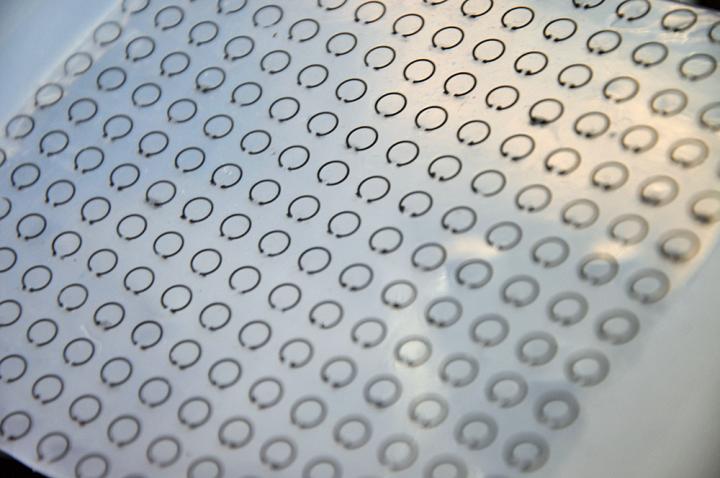Iowa State engineers develop flexible skin that traps radar waves, cloaks objects

This flexible, stretchable and tunable "meta-skin" can trap radar waves and cloak objects from detection. Credit: Liang Dong/Iowa State University
The meta-skin takes its name from metamaterials, which are composites that have properties not found in nature and that can manipulate electromagnetic waves. By stretching and flexing the polymer meta-skin, it can be tuned to reduce the reflection of a wide range of radar frequencies.
The journal Scientific Reports recently reported the discovery online. Lead authors from Iowa State's department of electrical and computer engineering are Liang Dong, associate professor; and Jiming Song, professor. Co-authors are Iowa State graduate students Siming Yang, Peng Liu and Qiugu Wang; and former Iowa State undergraduate Mingda Yang. The National Science Foundation and the China Scholarship Council have partially supported the project.
“It is believed that the present meta-skin technology will find many applications in electromagnetic frequency tuning, shielding and scattering suppression,” the engineers wrote in their paper.
Dong has a background in fabricating micro and nanoscale devices and working with liquids and polymers; Song has expertise in looking for new applications of electromagnetic waves.
Working together, they were hoping to prove an idea: that electromagnetic waves – perhaps even the shorter wavelengths of visible light – can be suppressed with flexible, tunable liquid-metal technologies.
What they came up with are rows of split ring resonators embedded inside layers of silicone sheets. The electric resonators are filled with galinstan, a metal alloy that's liquid at room temperature and less toxic than other liquid metals such as mercury.
Those resonators are small rings with an outer radius of 2.5 millimeters and a thickness of half a millimeter. They have a 1 millimeter gap, essentially creating a small, curved segment of liquid wire.
The rings create electric inductors and the gaps create electric capacitors. Together they create a resonator that can trap and suppress radar waves at a certain frequency. Stretching the meta-skin changes the size of the liquid metal rings inside and changes the frequency the devices suppress.
Tests showed radar suppression was about 75 percent in the frequency range of 8 to 10 gigahertz, according to the paper. When objects are wrapped in the meta-skin, the radar waves are suppressed in all incident directions and observation angles.
“Therefore, this meta-skin technology is different from traditional stealth technologies that often only reduce the backscattering, i.e., the power reflected back to a probing radar,” the engineers wrote in their paper.
As he discussed the technology, Song took a tablet computer and called up a picture of the B-2 stealth bomber. One day, he said, the meta-skin could coat the surface of the next generation of stealth aircraft.
But the researchers are hoping for even more – a cloak of invisibility.
“The long-term goal is to shrink the size of these devices,” Dong said. “Then hopefully we can do this with higher-frequency electromagnetic waves such as visible or infrared light. While that would require advanced nanomanufacturing technologies and appropriate structural modifications, we think this study proves the concept of frequency tuning and broadening, and multidirectional wave suppression with skin-type metamaterials.”
###
Contacts:
Liang Dong, Electrical and Computer Engineering, 515-294-0388, ldong@iastate.edu
Jiming Song, Electrical and Computer Engineering, 515-294-8396, jisong@iastate.edu
Mike Krapfl, News Service, 515-294-4917, mkrapfl@iastate.edu
Media Contact
All latest news from the category: Information Technology
Here you can find a summary of innovations in the fields of information and data processing and up-to-date developments on IT equipment and hardware.
This area covers topics such as IT services, IT architectures, IT management and telecommunications.
Newest articles

Security vulnerability in browser interface
… allows computer access via graphics card. Researchers at Graz University of Technology were successful with three different side-channel attacks on graphics cards via the WebGPU browser interface. The attacks…

A closer look at mechanochemistry
Ferdi Schüth and his team at the Max Planck Institut für Kohlenforschung in Mülheim/Germany have been studying the phenomena of mechanochemistry for several years. But what actually happens at the…

Severe Vulnerabilities Discovered in Software to Protect Internet Routing
A research team from the National Research Center for Applied Cybersecurity ATHENE led by Prof. Dr. Haya Schulmann has uncovered 18 vulnerabilities in crucial software components of Resource Public Key…





















